Hi Everyone,
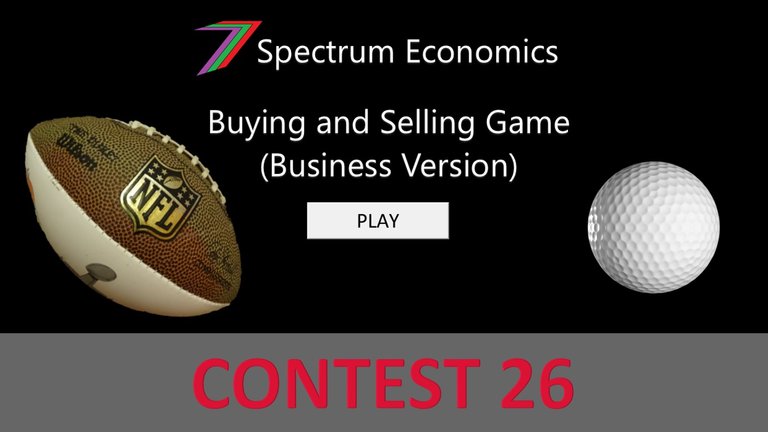
Welcome to the ‘Buying and Selling’ Game (Business Version)
In February, I am running the business version of the Buying and Selling Game. I am currently alternating monthly between the original version and the business version. I introduced the business version in my post/video 'Buying and Selling Game (Business Version) Explanation Video'. The video explains how the game is played and how a winner is determined. The business version was also used for Contest 19, Contest 21, Contest 23 and Challenge 6 of the Economics Challenge series. I recommend that you look at the video as well as at least one of the other contests to get a better idea of how to play.
How to play?
The ‘Buying and Selling’ Game (Business Version) involves two simple steps.
- Choose the quantity of each good you want to buy or make.
- Choose the selling price of each good you bought or made.
All the information you need to know to play the game is provided in the question; i.e. no external research is required as all costs and demand estimates are hypothetical.
All entries must be made in the comments section of this post.
Each account is only permitted one entry.
Objective of the game
The objective of the game is to make the highest profit from the sale of the goods you have bought or made. If two participants make the exact same profit, the participant that entered first wins.
If nobody makes a profit (i.e. nobody enters the contest or if all participants make a loss), the prize of 30 Hive will be rolled over to the next contest. Therefore, the prize for the next contest will be 60 Hive.
Game assumptions
Each good has 100 potential customers. Each customer can buy up to 6 items of a particular good if he or she values the goods above the selling price (i.e. has a willingness-to-pay higher than the selling price). Each customer is only interested in one type of good. Therefore, selling more types of goods increases the potential number of customers. For example, selling three types of goods grants access to 300 potential customers.
Demand for the goods for each customer is determined using triangle distributions. The question provides the minimum, maximum, and mode willingness-to-pay for each good. Demand is further adjusted for diminishing marginal utility using a fixed percentage adjustment. The demand curve is the summation of demand of all potential customers. See example of triangle distribution below. A sample demand curve is shown later in the post.
Selling Price Distribution
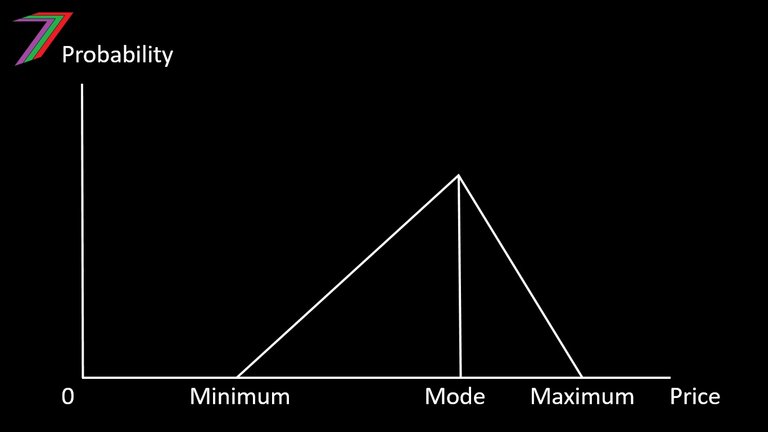
Each customer has diminishing utility (diminishing willingness-to-pay as more goods are bought) for each good. For example, a customer may have a willingness-to-pay of $1.00 for the first item, $0.80 for the second item, $0.60 for the third item, $0.40 for the fourth item, $0.20 for the fifth item, and $0.00 for the sixth item. The question will state this diminishing utility as 20% (i.e. 0.2/1 = 20%), which is applied linearly. If a participant prices the good at $0.50, the customer will buy three items, as the customer values the fourth item below $0.50 (i.e. $0.40).
The business will have overhead costs, which need to be deducted from the budget before goods can be bought. There are zero transaction and transport costs.
If some goods remain unsold, they will be treated as being wasted, which is equivalent to being sold for $0. This could occur if a participant prices a good too high.
What information is provided?
- All the goods that can be bought in the game are provided.
- All costs (i.e. costs to buy/make goods and overhead costs) are provided.
- Any special purchasing requirements are provided. For example, a good may need to be bought in fixed quantities.
How are the results of the game determined?
A Microsoft Excel Model is used to determine the demand of each good. The costs, quantities bought, quantities sold, and prices will be used to calculate the profits made by each participant. In the results post, the calculation of the demand and profits will be presented in a video.
Contest Prizes
The account with the winning entry will receive 30 Hive and the first 12 entries will be given upvotes. The winner will receive an additional 5 Hive, if he or she obtains a higher profit than the model’s internal estimator.
Let the contest begin
For Contest 26 of the Buying and Selling Game (Business Version), participants will be running a sports ball shop. This is a reference to my inability to get the ball rolling with some of my other content.
Participants will be able to sell three types of balls.
- Golf Balls
- Footballs
- Tennis Balls
The participants will only be able to purchase the golf balls in batches of 20, the footballs in batches of 5, and the tennis balls in batches of 30. The costs of purchasing each batch, the average cost per ball and daily overheads are provided in the tables below.
Cost Information

Note: Budget includes Daily Overhead. If the budget is $600 and the daily overhead is $100, there is $500 remaining to purchase balls.
The parameters to determine demand are provided in the table and graphs below.
Demand Information
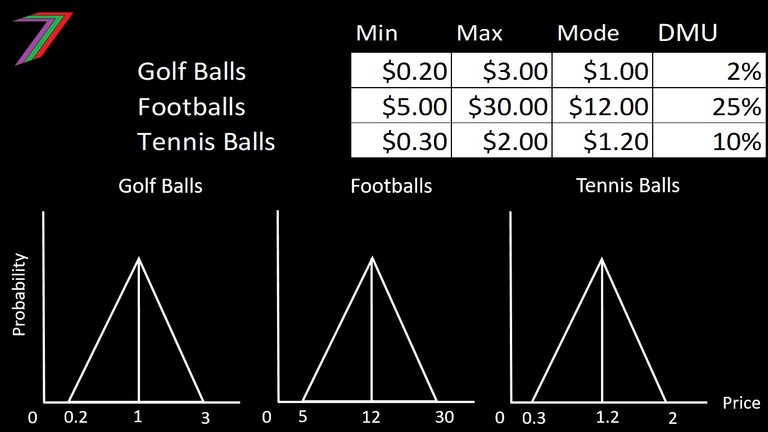
Note: The graphs for the triangle distribution are based on the minimum, maximum, and mode prices for the first ball a customer buys. The demand curve is adjusted to include diminishing utility expressed in the last column of the table. This will affect the elasticity of demand.
It has been assumed each type of ball has 100 potential customers. Each customer will potentially buy a maximum of 6 balls. Therefore, it is possible a maximum of 600 of each ball could be sold. The Figure below contains a sample of a possible demand curve that could be generated by the model using the parameters described in this question.
Possible Demand Curve
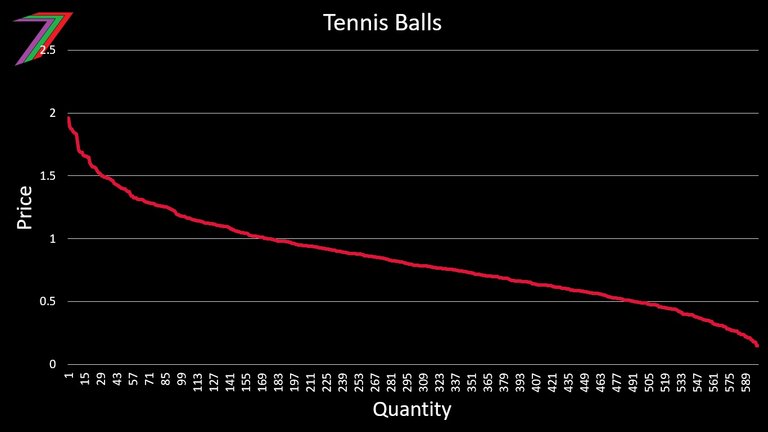
Note: Sample demand curve for tennis balls. Actual demand curve will be determined in the results post.
Entry format
For this contest, I expect to see entries made in the following format:
Golf Balls
Quantity: XXX Selling Price: XXX
Footballs
Quantity: XXX Selling Price: XXX
Tennis Balls
Quantity: XXX Selling Price: XXX
Example:
Golf Balls
Quantity: 100 (5 batches) Selling Price: $2.50
Footballs
Quantity: 15 (3 batches) Selling Price: $20
Tennis Balls
Quantity: 300 (10 batches) Selling Price: $2.10
The closing date and time for this contest is 6PM coordinated universal time (UTC) 24/02/2022. Responses after this time will not be accepted. The answers will be provided in the results post along with the video containing the generation of demand and profits using the model.
I hope everyone has fun and enjoys the business version of the contest. If you have any questions, feel free to ask in the comments section.
More posts
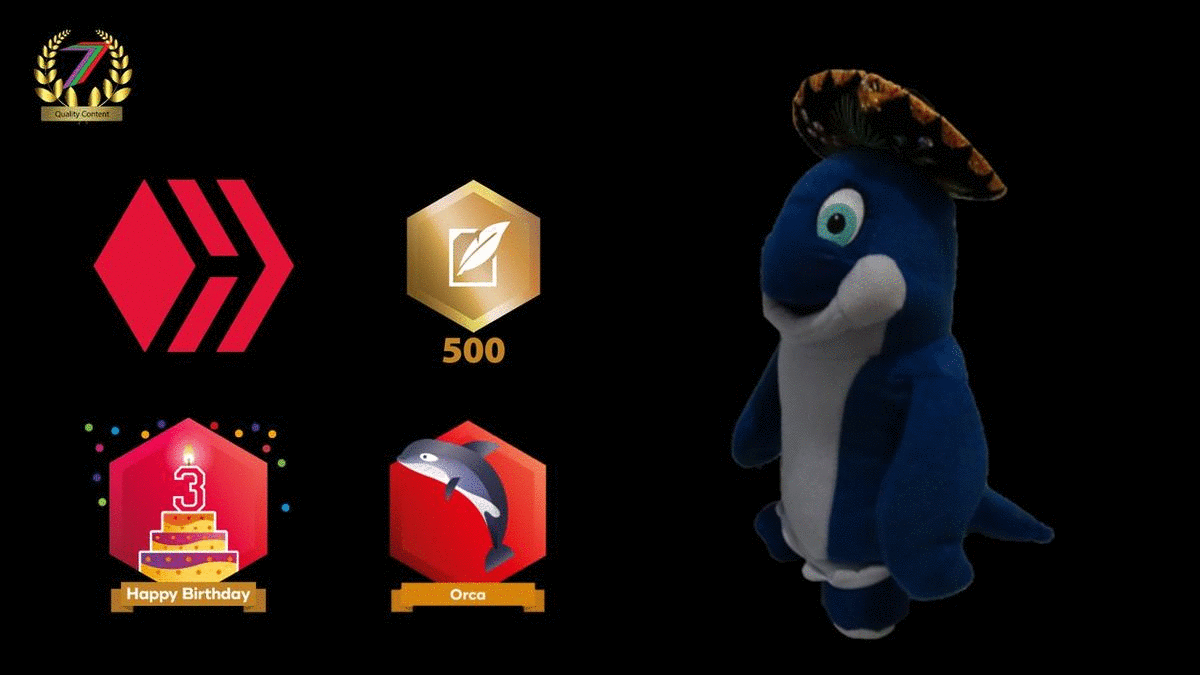
If you want to read any of my other posts, you can click on the links below. These links will lead you to posts containing my collection of works. These 'Collection of Works' posts have been updated to contain links to the Hive versions of my posts.
My CBA Udemy Course
The course contains over 10 hours of video, over 60 downloadable resources, over 40 multiple-choice questions, 2 sample case studies, 1 practice CBA, life time access and a certificate on completion. The course is priced at the Tier 1 price of £20. I believe it is frequently available at half-price.
Future of Social Media






Golf Balls
Quantity: 240 (12 batches) Selling Price: $1.2
Footballs
Quantity: 30 (6 batches) Selling Price: $12.60
Tennis Balls
Quantity: 60 (2 batch) Selling Price: $1.35
Golf Balls
Quantity: 220 (11 batches) Selling Price: $1.18
Footballs
Quantity: 35 (7 batches) Selling Price: $12.5
Tennis Balls
Quantity: 30 (1 batch) Selling Price: $1.30
Golf Balls
Quantity: 240 (12 batches) Selling Price: $1.18
Footballs
Quantity: 30 (6 batches) Selling Price: $12.74
Tennis Balls
Quantity: 60 (2 batch) Selling Price: $1.30
Golf Balls
Quantity: 220 (11 batches) Selling Price: $1.20
Footballs
Quantity: 35 (7 batches) Selling Price: $12.35
Tennis Balls
Quantity: 30 (1 batch) Selling Price: $1.30
Golf Balls
Quantity: 200 (10 batches) Selling Price: $2
Footballs
Quantity: 20 (4 batches) Selling Price: $28
Tennis Balls
Quantity: 180 (6batches) Selling Price: $1.20
Golf balls
Quantity: 220 (11 batches) selling price: $1.15
footballs
Quantity: 30 (5 batches) selling price: $11.50
Tennis balls
Quantity: 30 (2 batches) selling price: $2.50
Golf Balls
Quantity: 220 (11 batches) Selling Price: $1.10
Footballs
Quantity: 35 (7 batches) Selling Price: $13
Tennis Balls
Quantity: 30 (1 batch) Selling Price: $1.20
Golf Balls
Quantity: 220 (11 batches) Selling Price: $1.18
Footballs
Quantity: 25 (5 batches) Selling Price: $12.74
Tennis Balls
Quantity: 120 (4 batches) Selling Price: $1.30
Thanks lot sir,I just noticed I won. I so much appreciate and excited as well. I so much appreciate 🙏🙏
The rewards earned on this comment will go directly to the person sharing the post on Twitter as long as they are registered with @poshtoken. Sign up at https://hiveposh.com.
Thanks alot for the reward sir, I just noticed I won the contest. I so much more appropriate,and I'm very excited. Thanks to all the contesters as well.